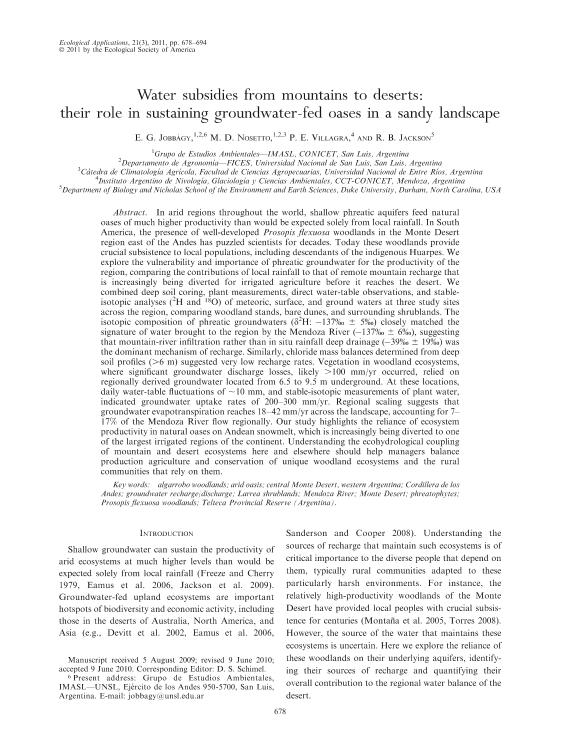Mostrar el registro sencillo del ítem
dc.contributor.author
Jobbagy Gampel, Esteban Gabriel

dc.contributor.author
Nosetto, Marcelo Daniel

dc.contributor.author
Villagra, Pablo Eugenio

dc.contributor.author
Jackson, Robert B.
dc.date.available
2017-04-20T22:06:31Z
dc.date.issued
2011-04
dc.identifier.citation
Jobbagy Gampel, Esteban Gabriel; Nosetto, Marcelo Daniel; Villagra, Pablo Eugenio; Jackson, Robert B.; Water subsidies from mountains to deserts: their role in sustaining groundwater-fed oases in a sandy landscape; Ecological Society of America; Ecological Applications; 21; 3; 4-2011; 678-694
dc.identifier.issn
1051-0761
dc.identifier.uri
http://hdl.handle.net/11336/15538
dc.description.abstract
In arid regions throughout the world, shallow phreatic aquifers feed natural oases of much higher productivity than would be expected solely from local rainfall. In South America, the presence of well-developed Prosopis flexuosa woodlands in the Monte Desert region east of the Andes has puzzled scientists for decades. Today these woodlands provide crucial subsistence to local populations, including descendants of the indigenous Huarpes. We explore the vulnerability and importance of phreatic groundwater for the productivity of the region, comparing the contributions of local rainfall to that of remote mountain recharge that is increasingly being diverted for irrigated agriculture before it reaches the desert. We combined deep soil coring, plant measurements, direct water-table observations, and stable-isotopic analyses (2H and 18O) of meteoric, surface, and ground waters at three study sites across the region, comparing woodland stands, bare dunes, and surrounding shrublands. The isotopic composition of phreatic groundwaters (delta2H: -137 per thousand +/- 5 per thousand) closely matched the signature of water brought to the region by the Mendoza River (-137 per thousand +/- 6 per thousand), suggestin that mountain-river infiltration rather than in situ rainfall deep drainage (-39 per thousand +/- 19 per thousand) was the dominant mechanism of recharge. Similarly, chloride mass balances determined from deep soil profiles (> 6 m) suggested very low recharge rates. Vegetation in woodland ecosystems, where significant groundwater discharge losses, likely >100 mm/yr occurred, relied on regionally derived groundwater located from 6.5 to 9.5 m underground. At these locations, daily water-table fluctuations of 10 mm, and stable-isotopic measurements of plant water, indicated groundwater uptake rates of 200-300 mm/yr. Regional scaling suggests that groundwater evapotranspiration reaches 18-42 mm/yr across the landscape, accounting for 7 17% of the Mendoza River flow regionally. Our study highlights the reliance of ecosystem productivity in natural oases on Andean snowmelt, which is increasingly being diverted to one of the largest irrigated regions of the continent. Understanding the ecohydrological coupling of mountain and desert ecosystems here and elsewhere should help managers balance production agriculture and conservation of unique woodland ecosystems and the rural communities that rely on them.
dc.format
application/pdf
dc.language.iso
eng
dc.publisher
Ecological Society of America

dc.rights
info:eu-repo/semantics/openAccess
dc.rights.uri
https://creativecommons.org/licenses/by-nc-sa/2.5/ar/
dc.subject
Algarrobo Woodlands
dc.subject
Arid Oasis
dc.subject
Central Monte Desert
dc.subject
Western Argentina
dc.subject
Cordillera de Los Andes
dc.subject
Groundwater Recharge/Discharge
dc.subject
Larrea Shrublands
dc.subject
Mendoza River
dc.subject
Monte Desert
dc.subject
Phreatophytes
dc.subject
Prosopis Flexuosa Woodlands
dc.subject
Telteca Provincial Reserve (Argentina)
dc.subject.classification
Ecología

dc.subject.classification
Ciencias Biológicas

dc.subject.classification
CIENCIAS NATURALES Y EXACTAS

dc.title
Water subsidies from mountains to deserts: their role in sustaining groundwater-fed oases in a sandy landscape
dc.type
info:eu-repo/semantics/article
dc.type
info:ar-repo/semantics/artículo
dc.type
info:eu-repo/semantics/publishedVersion
dc.date.updated
2017-04-18T17:02:33Z
dc.identifier.eissn
1939-5582
dc.journal.volume
21
dc.journal.number
3
dc.journal.pagination
678-694
dc.journal.pais
Estados Unidos

dc.journal.ciudad
Nueva York
dc.description.fil
Fil: Jobbagy Gampel, Esteban Gabriel. Consejo Nacional de Investigaciones Científicas y Técnicas. Centro Científico Tecnológico Conicet - San Luis. Instituto de Matemática Aplicada de San Luis "Prof. Ezio Marchi". Universidad Nacional de San Luis. Facultad de Ciencias Físico, Matemáticas y Naturales. Instituto de Matemática Aplicada de San Luis "Prof. Ezio Marchi"; Argentina. Universidad Nacional de San Luis. Facultad de Ingeniería y Ciencias Económico Sociales; Argentina
dc.description.fil
Fil: Nosetto, Marcelo Daniel. Universidad Nacional de San Luis. Facultad de Ingeniería y Ciencias Económico Sociales; Argentina. Consejo Nacional de Investigaciones Científicas y Técnicas. Centro Científico Tecnológico Conicet - San Luis. Instituto de Matemática Aplicada de San Luis "Prof. Ezio Marchi". Universidad Nacional de San Luis. Facultad de Ciencias Físico, Matemáticas y Naturales. Instituto de Matemática Aplicada de San Luis ; Argentina. Universidad Nacional de Córdoba. Facultad de Ciencias Agropecuarias. Cátedra de Climatología Agrícola; Argentina
dc.description.fil
Fil: Villagra, Pablo Eugenio. Consejo Nacional de Investigaciones Científicas y Técnicas. Centro Científico Tecnológico Conicet - Mendoza. Instituto Argentino de Nivología, Glaciología y Ciencias Ambientales. Provincia de Mendoza. Instituto Argentino de Nivología, Glaciología y Ciencias Ambientales. Universidad Nacional de Cuyo. Instituto Argentino de Nivología, Glaciología y Ciencias Ambientales; Argentina
dc.description.fil
Fil: Jackson, Robert B.. University Of Duke; Estados Unidos
dc.journal.title
Ecological Applications

Archivos asociados
